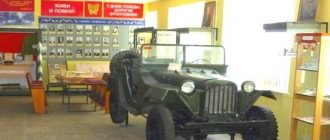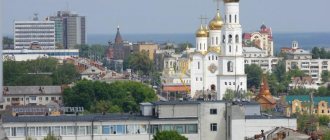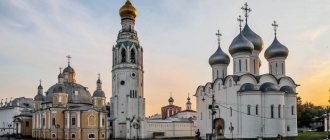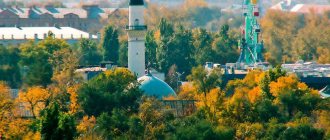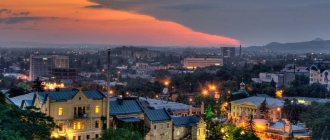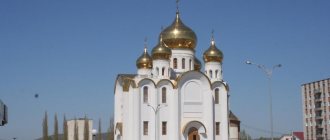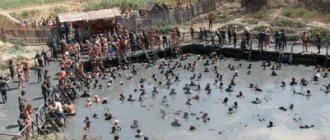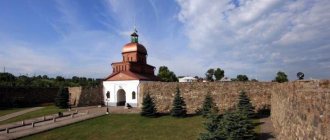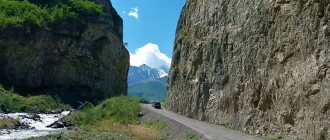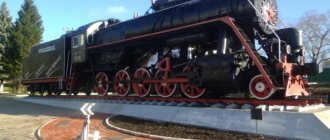Sights of Almetyevsk
Historical information. The city of Almetyevsk is located in the Republic of Tatarstan of the Russian Federation and forms the Almetyevsky district. It is the fourth largest city in Tatarstan - about 158 thousand inhabitants. The village of Almetyevo arose in the 19th century, around 1719. There are no exact historical documents available. The village was founded by Mullah Almet.
Only in 1952 the settlement received the status of a village, and in 1953 the status of a city. The city is located 265 km from Kazan.
Almetyevsk is home to many oil industry enterprises - the city can be called the oil capital of Tatarstan. Almetyevsk is small, but clean, cozy and beautiful city with many beautiful places and a considerable number of local attractions.
10 best hotels in Almetyevsk (from RUB 1,606) Booking =>>
Religious sights of Almetyevsk
So, what places can you start exploring the city with? This town is definitely worth visiting for travelers who are attracted by religious attractions: Almetyevsk has several of them. For example, you can’t help but visit the Temple of the Icon of the Kazan Mother of God. It is believed that it is similar to the Cathedral of Christ the Savior located in the capital. The building is two-story, and the second floor alone can accommodate approximately a thousand people. The cathedral's belfry has 11 bells, the largest one weighs 1350 kg.
What other religious attractions are of interest? Almetyevsk is a settlement on the territory of which the Church of the Nativity is located. This building does not belong to the category of ancient buildings; its lighting was done relatively recently - in 2000. The temple was erected in honor of the fallen defenders of the Motherland. The creators of the brick church were inspired by the design of the Alexander Nevsky Chapel, located in Yaroslavl.
Kazan Cathedral
Among the religious attractions of Almetyevsk, one can note the Kazan Cathedral, which is recognized as the largest Orthodox shrine in the city. The construction of the temple began in 2000 and lasted for 7 years.
The snow-white cathedral with golden domes is the most visited spiritual center of Almetyevsk.
The temple has a unique porcelain iconostasis. The floor is laid with multi-colored mosaics, specially brought from Italy. The cathedral has a belfry consisting of 11 domes, which were cast in the Yaroslavl region.
The temple is located on Stroiteley Avenue, building 50 and is open daily.
Cascade of ponds
Of course, the city is able to offer its guests not only religious attractions. Almetyevsk is a settlement whose symbol is considered to be the Cascade of Ponds. What makes this place mysterious is that there was once a swamp on its territory.
The Cascade of Ponds is a water-architectural complex with green spaces and walking paths where locals like to gather. It enjoys invariably high popularity among city guests. Here people walk, ride bicycles, and have picnics. A couple in love should definitely visit here. Legend has it that if you kiss your loved one on Lover's Bridge, the relationship will last forever.
Aktash Proval
Not far from the city there is a lake called Aktashsky Proval, which in 2005 was recognized as a natural monument of regional significance.
In August 1939, a tractor was working in a field near the village of Kaleikino. The unsuspecting tractor driver drove the tractor in the direction of one of the hills, and suddenly a gap formed below, into which the tractor and the tractor driver fell.
They were unable to get the tractor driver out, and the place acquired a bad reputation among local residents. A lake with clean and transparent water formed at the bottom of the hole. Several attempts were made to descend into the depths of the hole and find the sources of the current. But they were never found.
The Aktash failure is something that every tourist tries to see in Almetyevsk (more precisely in the Almetyevsky district). After all, according to legend, if you throw a pebble into the lake and make a wish, it will definitely come true.
Museums
What other interesting places is Almetyevsk famous for? Its attractions are varied. Of course, all guests of the city should definitely visit the Museum of Local Lore. Here they will have an excursion, during which they can learn interesting facts about the history of the settlement and the development of the oil industry. The museum has many interesting exhibits that allow you to better imagine the life of the people who lived in this place in the 19th and 20th centuries. Tourists will also be able to admire a working model of a 19th century water mill.
The art gallery is another must-see place. Mostly works dedicated to the production of Tatar oil are presented here. There are many interesting works by the famous artist Konrad Maksimov, who praises the nature of the Kama and Volga in his canvases.
photo, description, map with addresses
To come in
Registration
Found 3 attractions in Almetyevsk
Select countryPopular countriesUSItalyJapanFranceUnited KingdomChinaRussiaGermanySpainBrazilAll countriesAbkhaziaAustraliaAustriaAzerbaijanAlbaniaAlgeriaAngolaAndorraArgentinaArmeniaAfghanistanBahamasBangladeshBahrainBelarusBelizeBelgiumBeninBulgariaBoliviaBosnia and HerzegovinaBotswanaBrunei Burkina Faso (Upper Volta)BurundiBhutanVanuatuVaticanHungaryVenezuelaEast TimorVietnamGuyanaGambiaGhanaGuatemalaGuineaHondurasGreeceGeorgiaDenmarkDenmark: GreenlandDominican RepublicEgyptZambiaWestern SamoaZimbabweIsraelIndiaIndonesiaJordanIranIrelandIceland YemenCape VerdeKazakhstanCambodiaCameroonCanadaQatarKenyaCyprusColombiaCongoCosta RicaCubaCook IslandsKyrgyzstanLaosLatviaLiberiaLebanonLibyaLithuaniaLiechtensteinLuxembourgMauritaniaMadagascarMacedoniaMalaysiaMaliMaldivesMaltaMoroccoMarshall IslandsMexicoM IronesiaMoldovaMonacoMongoliaMyanmarNamibiaNepalNigerNigeriaNetherlandsNicaraguaNiueNew ZealandNew CaledoniaNorwayUAEOmanPakistanPalauPanamaPapua New GuineaParaguayPeruPolandPortugalRwandaRomaniaSalvadorSan MarinoSan Tome and PrincipeSaudi ArabiaSe faithful KoreaSeychellesSenegalSerbiaSingaporeSyriaSlovakiaSloveniaSudanSurinameSierra LeoneTajikistanThailandTaiwanTanzaniaTogoTunisiaTurkmenistanTurkeyUgandaUzbekistanUkraineUruguayFaroe IslandsFijiPhilippinesFinlandFrance: ReunionFrench PolynesiaChor VatiaChadMontenegroCzech RepublicChileSwitzerlandSwedenSri LankaEcuadorEritreaEstoniaEthiopiaSouth AfricaSouth KoreaJamaica
Select cityPopular resortsMoscowSt. PetersburgMoscow regionEkaterinburgKazanNovosibirskVolgograd regionKrasnoyarskNizhny NovgorodTomskAll resortsIrkutskSochiChelyabinskKaliningradKaluga regionSamaraVladivostokPskov regionRostov-on-DonEagleOmskUfaYaroslavlTyumenRyazanPermAstrakhan ArkhangelskVoronezhCrimeaVeliky NovgorodTulaYaltaKhabarovskVladimirVologdaUlyanovskAbakanTverKrasnodarSaratovSevastopolKostromaOrenburgKirovIvanovoSmolenskYoshkar-OlaBelgorodSuzdalBarnaulIzhevskMurmanskSyktyvkarPenzaKurskKislovodskPervouralskPetrozavodskCheboksary VyborgNizhnevartovskKemerovoNovorossiyskPereslavl-ZalesskyTolyattiFeodosiaBryanskTaganrogPyatigorskAlushtaUglichUlan-UdeYuzhno-SakhalinskYakutskAnapaEvpatoriaNizhny TagilKurganTambovTobolskTuapseNovokuznetskSurgutBlagoveshchenskRybinskChitaZhelezno VodskRostov VelikyKhanty-MansiyskVladikavkazPetropavlovsk-KamchatskyMinesLipetskSaranskStavropolStaraya RussaKomsomolsk-on-AmurMagnitogorskMyshkinCherepovetsAzovVeliky UstyugGelendzhikEyskKerch
www.turizm.ru
Monuments
One cannot ignore the monuments when describing the sights of Almetyevsk. The photo of the Oil Monument below gives some idea of this grandiose structure. Its construction was completed in 2007, it is dedicated to the production of three billion tons of oil. The majestic monument depicts a stream of “black gold” that bursts out of the bowels of the earth.
A memorial dedicated to the heroes of the Great Patriotic War can be found behind the Drama Theater. Nearby there is a monument to the 60th anniversary of Tatarstan oil; it is located in the park of the same name. In the park you can also find a spectacular light and sound fountain.
Drama Theater
The Tatar Drama Theater was created in 1944. Performances in Russian and Tatar languages take place on its stage. The building itself has a solemn appearance and consists of two floors. A wide snow-white staircase leads to the central hall of visitors.
The theater lives an intense creative life. Thanks to its great potential and active touring activities, the theater is known far beyond the borders of Tatarstan. In the case when the performance is presented in the Tatar language, for the convenience of Russian-speaking spectators, there are headphones on each chair through which the translation is broadcast.
The theater building is located in the city center at the address: Lenin Street, 37.
Estate of landowner Pasmurov
The sights of Almetyevsk, a description with the name of which is offered in the article, certainly deserve attention. However, even outside the village you can find many amazing places. The estate of the landowner Pasmurov is located in the village of Novonikolskoye. It is known that it was built during the reign of Catherine the Great. Its first owner was a capital resident, Pasmurov, who suddenly wanted to enjoy the provincial silence.
Unfortunately, today only a perfectly preserved red-brick outbuilding, decorated with arched windows, tells about the former splendor of the estate. On the territory that was once occupied by the mansion, the Novonikolsk school is located. Once inside the building, you can admire the photographs of the estate taken by the author, whose name remains a mystery. The photographs reveal that Pasmurov’s property was once a majestic three-story mansion with snow-white columns.
Galeev Mosque
The next spiritual attraction of the city of Almetyevsk is the mosque named after Rinat Galeev, which is located on Mardzhani Street. It was built in the 90s, and named after the former director of Tatneft JSC, who made a significant contribution to its construction.
The mosque building is located on a small hill, made according to the dome type of structure with the main minaret at the top. The interior is decorated with multi-colored ceramic tiles and stained glass windows.
One part of the mosque is a prayer hall, and can accommodate 1,200 people. In the other there is a conference room and utility rooms.
Akhmetshin Museum
Not all noteworthy sights of Almetyevsk are mentioned above. A description (with names) of all objects would take a lot of space, but we are limited to the scope of just one article, so we focus on the most interesting ones. The Akhmetshin Museum is located in a nearby village called Nizhnee Abdulovo. Tourists can enjoy seven halls displaying amazing exhibits. Here you can find valuable archaeological finds dating back to the Bronze Age. Of course, there are also items that allow you to get an idea of the life and traditions of the Tatar people, for example, national jewelry and dishes.
In addition to all of the above, in the museum you can see stuffed animals and birds, including mutants. For example, among the exhibits there is a gosling with four legs, and there is also a ram’s head decorated with four horns. Finally, one room is completely dedicated to the works of the artist Khaliulla Akhmetshin, who founded the museum.
Historical reference
The exact date of foundation of Almetyevsk is unknown. It is believed that this happened in the 20-30s of the 18th century. Thus, in 1840, during a survey, local residents reported that their settlement was founded 121 years ago, that is, in 1719. The first written mentions date back to 1735−1740, the time of the Bashkir uprising. A letter from Mullah Almet, considered the founder of the settlement, to Colonel Tatishchev about the plans of the rebels and their danger also dates back to these years.
By the end of the 18th century, 700 Bashkirs and Teptya lived here. According to the census of the mid-19th century, Almetyevsk already had 2 factories, a fair and bazaar, a mosque, a postal station, and more than 1.5 thousand residents.
The status of the settlement changed as follows:
- Since 1930 it has been a regional center.
- Since 1952 - an urban-type settlement.
- Since 1953 - a city of the Autonomous Soviet Socialist Republic.
Today Almetyevsk is an economically developed city in which several large companies operate: several oil companies, including Tatneft, a road company, factories for the production of oil and gas pipes and pumps, and others.
Sports are developed here: hockey and cross-country skiing, rugby, football, aeronautics. The city boasts several sports teams and sports complexes, including a ski resort, bicycle and skate parks.
Interesting fact: the city has a unique cycling infrastructure, thanks to which the bicycle is extremely popular here and is in demand as a personal vehicle. Its popularization helped reduce mortality by 20%.
Team Nomads
From an economic point of view, Tatarstan is roughly Russia in miniature. The east of the republic works: Nizhnekamsk, Nab. Chelny, Almetyevsk, Yelabuga, but Kazan, like Moscow, manages and manages the financial resources of the Republic of Tatarstan. If anyone doubts, they can look at industrial production per capita of each city, namely real production, since the industry of Kazan is often focused on itself - for banks, shops, construction, entertainment, etc. - this is a pure transfer of money earned from the sale of oil, petroleum products, petrochemical products, machinery, equipment, agricultural products, etc. And these products are mainly supplied by the industrial east of the Republic of Tatarstan, much like the Urals and Siberia - for the whole of Russia! I would like to talk about one such labor city - Almetyevsk - in this article, since on my business I worked in this interesting city. Almetyevsk has changed a lot and become more beautiful over the past 15-20 years, while it is not only a city of oil workers, but also an interesting cultural and historical center of the Trans-Kama region.
Almetyevsk (Tat. Әлмәт) is a city (since November 3, 1953) in Russia, the administrative center of the Almetyevsky district of Tatarstan, the largest city in the polycentric Almetyevsk-Bugulma-Leninogorsk agglomeration and the center of the TPK of the South-Eastern economic zone of the republic, the fourth in population and importance city of Tatarstan.
The city is located in Zakamye, on the slopes of the Bugulma-Belebeevskaya Upland, on the left bank of the Zai River (a tributary of the Kama), 265 km southeast of Kazan, 13 km from the Almetyevskaya railway station. The area of the city is 41 km². Almetyevsk is located 39 km from Leninogorsk and its largest Romashkinskoye field in the Volga-Ural province in the south of Tatarstan. Today, the Romashkinskoye field is one of the largest oil fields in the world.
Climate Average annual air temperature - 4.4 °C Average wind speed - 3.8 m/s.
Almetyevsk city steam locomotive at the railway station
HISTORY OF THE FOUNDATION OF ALMETYEVSK For many years after joining the Moscow state, the territory of the modern South-East of Tatarstan remained practically undeveloped. Until the 1630s The history of the region was connected with the Nogai Horde. After the departure of the Nogai Tatars under pressure from the Kalmyks to the Black Sea steppes, these lands were completely empty. The service Tatars and Tarkhans, “yasak Chuvashs” and bobyls, who owned lands in the basins of the Ika, Kineli, Soka and other rivers, used their estates only “in raids” due to the constant threat of Kalmyk raids. There were practically no settlements south of the territory of the modern Sarmanovsky district. Intensive settlement of the region began only in the first third of the 18th century. One of the settlements that emerged during this period was the village of Almetyevo. There is no exact information about the time of its foundation. However, a number of indirect evidence suggests that this event occurred at the turn of the second and third decades of the 18th century. In 1840, during a survey conducted in the region, Almetyevsk residents reported to the authorities that their village was founded 121 years ago, i.e. around 1719.
Materials from the period of the second revision (1747) recorded the presence in the village of Almet-Mullino (the second name of the village of Almetyevo in the 18th century - R.A.) of 23 households and 85 male souls. For that time it was a fairly large village. Its formation took place during the years when the authorities did their best to prevent the flight of Tatars to the border regions of the Russian state. In reality, it took decades for the settlement to reach this size. Therefore, there is reason to believe that the village of Almetyevo was founded long before the second revision. Possibly during the first revision (1719 - 1724). The clarification of this date is closely related to the problem of establishing the identity of the founder of the village. The first mention of the village of Almetyevo in written sources is contained in documents dating back to the initial period of the uprising of 1735-1740. Among them, a letter from Mullah Almet to Colonel I.N. has been preserved. Tatishchev, which reported “on the congresses and intentions” of the rebels and both dangers for the population of the Nadyrovskaya volost. The letter is dated June 24, 1735 and ends with the words: “I, Almet-mullah, wrote this letter to Zaya from the Almeteva village.” The last phrase, with the scarcity of other sources, is a key link in our subsequent logical constructions. Mullah Almeta's name appears in two other documents dating back to the 1730s. The first of them, dating back to July 9, 1734, is associated with clashes between residents of the Yurma volost and a detachment of the Tobolsk Dragoon Regiment. This document mentions Mullah Almet from across the river. Zay. The second document tells about the events of the early summer of 1735, when a council of participants in the uprising took place in the village of Bigashevo. Among those present there were Akai Kusyumov, Kilmyak Abyz, Mrat-Sultan and other famous leaders of the rebels. Representatives from dd also participated in the council. Ursala, Ursalabash, Bigashevo, Almetyevo, Maktama-Tamak and Maktama-Bash, among which Almet mullah Karatametev from the village of Almetyevo is mentioned. Until recently, the prevailing opinion among historians and local historians was that the village of Almetyevo on the river. Zai was founded by Almukhamet, a native of the village of Almetyevo, Baylyarsky volost (now the village of Almetyevo, Sarmanovsky district). In this case, they usually referred to the text of the shedjere of Bikchura Khan, recorded by Riza Fakhretdinov. In the indicated shedger there is indeed Almuhammet from the village of Almetyevo, whose family tree looks like this: Bikchura - Gabdulla Ilaz - Siman - Yakup - Yanbulat - Bikmet (Bikmuhammet) - Karatuymet (Tuimuhammet) - Almuhammet. Almuhammet had three sons: Rahmatullah, Gabderahim and Rahmankul (Ramai). This is where the Almuhammet line ends.
in the local history museum City of Almetyevsk
In the text part of the shedzhere it is noted that Almuhammet, a native of the Bailar volost, was the founder of two villages: Old Almet-Mullino (in the Bailar volost near the Menzel river) and Bazarly Almet-Mullino - on the river. Zay. It is also noted that Almuhammet in the village of Almet-Mullino on the river. Zay “stayed for a short time.” One of his sons, Rakhmatulla, lived in the village of Almet-Mullino, the other, Gabderakhim, lived in the village of Taisuganovo6. In the same Taisuganovo, apparently, Rakhmankul (Ramai) also lived, who, in our opinion, is directly related to the famous Tatar family of industrialists Rameevs, natives of the village of Taisuganovo, who moved into the 18th century. for residence in Sterlitamak district, and later in Orenburg. Shedzhere is an undoubtedly important source, but it needs to be compared with data from other sources. This opportunity is provided by the materials of the 7th revision (1816). According to them, in the village of Almetyevo, among the “Bashkir” population was Rakhmatulla Almuhammetov, who by the time of the 6th revision in 1811 was 77 years old (born around 1734, died in 1813). At the time of Rahmatullah’s birth, his father Almuhammet could have been 20, 30, 40, 50, 60, etc. years. That is, there is a fairly high probability that in the early 1720s, he was already a mature man, capable of founding a settlement or even two. One way or another, Almu-khamet Karatuimetov from the shedzhere of Bikchura Khan and Almet-mulla Karatametev, who was present at the council of the rebels in the village of Bigashevo in the summer of 1735, are undoubtedly the same person associated with the village of Almetyevo on the river. Zay. There is another point of view about the founder of the village of Almetyevo. In the Almetyevsk region, a more or less complete census of the population was first carried out during the second revision (1746 - 1747). At the same time, the “Bashkir” population was not subject to the census. According to the census documents of the second (1746) and third (1762) revisions, in the village of Almetyevo there was only one person named Almet, the son of Seit. In 1746 he was 49 years old, i.e. he was born around 1697. At the time of the third audit he was 65 years old8. Almet Seitov had six sons: Yusup (1722 - 1761), Khalil (1731 - 1748), Masgud (1733 pp), Ishtan (b. 1735), Arslanbek (1744 - 1795) and Gadelsha (1758 - 1795)9. In 1764, the name Almet Seitov was recorded in the list of owners of mills in the region. In this case, his last name is given as Sagitov10. Thus, there are two historical figures who claim to be called the founder of the village of Almetyevo. At the same time, the main argument against the candidacy of Almet Karatuimetov (Tuimukhametov), a native of the Baylyar volost, is his “Bashkir” origin. The fact is that the Nadyrovskaya volost, which included the village of Almetyevo, was not a Bashkir tribal unit. In historical sources it is mentioned as the Nadyrevoy volost of the service Tatars. That is, the “Bashkir” population in the Nadyrovskaya volost could only be newcomers. During the General Land Survey, which took place in the Eastern Trans-Kama region at the end of the 18th - beginning of the 19th centuries, information was collected from residents of some villages in the region about the time of their settlement in the Nadyrovskaya volost.
City Almetyevsk Alley of Heroes in the city park
At the same time, the Teptyars and Yamsk Tatars were recognized as the “ancient inhabitants” of the volost. The “Bashkir” population in all identified cases indicated settlement in the volost with the permission of the foreman Nadyr Urazmetov (he received this rank around 1736) or the Tatars. For example, the “Bashkirs” settled in the village of Karataevo around 1750, in the village of Yultimirovo - around 1765, in the village of Nadyrovo (Sugushly) - around 1790. The “Bashkir” population of the villages of Shugurovo and Abdrakhmanovo “did not remember” the time of their relocation. This also applies to the Bashkir-Baylar residents of the village of Taisuganovo, including the descendants of Almukhamet, who lived in this village and moved “from the village of Almetyevo, Menzelinsky district, with the permission of the elder Nadyr Urazmetov from a long time ago.” Considering that the final resettlement of Nadyr Urazmetov to the land “granted” to him on the banks of the river. Zai occurred only in 1729; the resettlement of the Bailar “Bashkirs” to Nadyrovskaya dates back to a later time. The Baylyar people are not mentioned among the first settlers of the village of Almetyevo, among whom were people from the village. Meshatamak and Selengushevo Nogai road of Kazan district, Tashkichu and Tazlarovo Alatskaya road of the same district, Nurlatovo of Simbirsk district, Kanadeevo of Penza district, Azimovo and Shlyankino of Sviyazhsk district. The arguments in favor of Almet Seitov’s “superiority” seem to us more weighty. The very appeal of Mullah Almeta to the command of the Sheshminsky landmilitsky regiment, dating back to 1735, indicates that already during this period he belonged to the ruling elite of the Nadyrov volost and was on good terms with Nadyr Urazmetov. Moreover, there is reason to believe that these two families subsequently became related. According to revision tales, the youngest son of the founder of the Nadyrovsky volost, Nadyr Urazmetov, Yagofar (b. 1759), had his first wife Gulyamsha (Goleisha) Almetova (b. 1762) from the village of Almetyevo. As already noted, Almet Seitov had six sons, the youngest of whom, Gadelsha, was born in 1758. Thus, it is likely that Gulyamsha was the daughter of Almet Seitov, since in 1764 he was still alive. In conditions where marriages, as a rule, were concluded between families of approximately equal status in society, this marriage speaks of the authority and social status of Almet Seitov (Sagitov) and his descendants. His material well-being is evidenced by the fact that he was the owner of a mill on the river. Ursala. Thus, the totality of the above facts allows us to assert that the village of Almetyevo (Almet-Mulino) on the river. Zay was founded by a 23-year-old Tatar, a Teptya by class, Mullah Almet Seitov around 1720.
Almetyevsk city
Almetyevsk city and region In 1795, 700 Teptyars and Bashkirs lived in the village, and in 1834 123 Bashkirs, 544 Teptyars. According to the materials of the 1859 audit, 1,518 state-owned peasants and Bashkirs, as well as a mosque, a postal station, a fair, bazaars and 2 factories were taken into account in the 214 courtyards of the village. Since 1920, as part of the Bugulma canton of the Tatar Autonomous Soviet Socialist Republic, since August 10, 1930 it has been a regional center. On March 25, 1952, the village of Almetyevo was transformed into an urban-type settlement, Almetyevsk, and on November 3, 1953, by decree of the Presidium of the Supreme Council of the RSFSR, it received the status of a city.
Economy Like most other cities and villages in the southeast of the republic, the city is highly dependent on the oil industry of Tatarstan. The oil office is located in Almetyevsk, from which the city receives the majority of budget revenues. In addition, the city is located: "Tatnefteprom" (the largest small oil (small oil (small oil company) Almetyevsky Pipeline (oil and gas pipelines), and other enterprises. The volume of goods shipped of its own production and work and services performed in-house in manufacturing industries for 2011 amounted to 28.83 billion rubles.In 1995, on the initiative of Gatin Robert Fatykhovich, Sadriev Miskhat Aukhadievich and the Almetyevsk Union of Industrialists and Entrepreneurs, a branch of the Chamber of Commerce and Industry of the Republic of Tatarstan was opened in the city of Almetyevsk, later called the South-Eastern Branch of the Chamber of Commerce and Industry RT and was headed by Gatin Robert Fatykhovich.
Almetyevsk district (2007): volume of shipped goods of own production - 222.8 billion rubles (1st place in the Republic) Almetyevsk is served by: the city bus station, the Almetyevskaya railway station of the Kuibyshev railway (Agryz-Akbash line) and Bugulma airport, located 13 kilometers away. The Druzhba main oil pipeline to foreign Europe originates from the city, and oil pipelines to Nizhny Novgorod, Perm, and Samara also pass through. City transport is represented by 5 trolleybus routes, about 20 bus and minibus routes, and taxis.
The federal highway passes through the city: P239 Kazan - Orenburg.
Architecture, sights of the Church: Temple of the Icon of the Kazan Mother of God (in 2013, the address of the temple was changed. Now it is Cathedral Square, no. 1), built in 2000-2007. Almetyevsk city
A new large double-altar cathedral, in shape and size reminiscent of the Moscow Cathedral of Christ the Savior, consisting of two floors (the upper church is dedicated to the Kazan Icon of the Mother of God, and the lower one to the Holy Myrrh-Bearing Women). The capacity of the upper temple alone is more than a thousand people. On the ground floor of the cathedral, in addition to the church, there is a Sunday school, a refectory (for 200 people), a kitchen and utility rooms. The cathedral's belfry consists of 11 bells, the largest of which weighs 1350 kg.
Church of the Nativity in memory of fallen soldiers. Consecrated in 2000. Located on the street. Timiryazev behind the Youth Center.
In the Almetyevsk region: wooden Kosmodemyanskaya Church (1736) in the village of Staraya Elan, Trinity Church (1791) in the village of Novotroitsk. Kazansko-Bogoroditskaya (1830, active) in the village of Russky Aktash; in the village of Verkhniy Aktash (1880); Nativity of Christ (1887) in the village of Yamashi, Sign of the Blessed Virgin Mary (1891) in the village of Novaya Mikhailovka, Pokrovskaya (1892, active) in the village of Kichuy, Pokrovskaya (late 19th century) in the village of Rokashevo.
Mosques: Cathedral Mosque (named after R.G. Galiev) 1990-1999 Second Cathedral Mosque 1872-1877 Mosque (1896, operational) in the village of Elhovo Muslim Religious Center named after. Riza Fakhretdin, a large new mosque.
Monuments: The Great Patriotic War Memorial behind the Drama Theater on Timiryazev Street at the entrance to the park of the 60th anniversary of Tatarstan oil. The monument to oil workers in front of the Neftche cultural center is one of the symbols of the city. Monument to the 60th anniversary of Tatarstan oil at the Central Roundabout Monument to Musa Jalil on the corner of the street. Musa Jalil and Lenin Monument to Lenin in front of the Tatar State Drama Theater Monument to the production of 3,000,000,000 tons of oil City of Almetyevsk
Museums, galleries, exhibition halls
Almetyevsk Art Gallery 423450, Republic of Tatarstan, Almetyevsky district, Almetyevsk, Stroiteley Ave., 35 Phone(s): (85512) 2-8281
Almetyevsk Local History Museum 423450, Republic of Tatarstan, Almetyevsky district, Almetyevsk, st. Mira, 1 Phone(s): (8553) 22-0422
exposition of a Tatar hut in the local history museum
Memorial Museum of Rizaeddin Fakhreddin 423422, Republic of Tatarstan, Almetyevsky district, Kichuchatovo Phone(s): (8553) 36-3718
Fatih Karimi Museum 423423, Republic of Tatarstan, Almetyevsky district, Minnibaevo village
Museum of the History of the Nizhnyaya Maktama Village Almetyevsk 423440, Republic of Tatarstan, Almetyevsky district, Nizhnyaya Maktama town, st. Sovetskaya, 55 Phone(s): (8553) 30-1465 fax: (8553) 36-1879
Museum of the History of the Village of Elhovo named after. Kh. Akhmetshina 423415, Republic of Tatarstan, Almetyevsky district, village. Nizhnee Abdulovo, st. Lenina, 27 Phone(s)
Sights: Pedestrian promenade on the street. Gagarin, richly decorated with artistic forging, garden sculpture and small architectural forms. Cascade of ponds with Lovers' Bridge and dam. The square in front of the Neftche cultural center. The estate of the landowner Pasmurov (17-18 centuries) in the village of Novonikolskoye. Monument to the production of 3,000,000,000 tons of oil
Culture Almetyevsk Youth Center Museum of Local Lore City Maidan Art Gallery named after. G.A. Stefanovsky - moved to the Neftche Palace of Culture "Neftche" Palace of Culture Almetyevsk Tatar State Drama Theater Youth Center District House of Culture NCC "Almat" Libraries Central Library City Park named after. 60th anniversary of Tatarstan oil Cinema "StarCinema" Cinema "Tatarstan"
Gagarin street in Almetyevsk
Sports Rugby Since 2001, a branch of the Moscow Rugby Club “Slava” has been operating. In October 2009, the club left the tutelage of the capital club and began to be called “ALDAN” AL-Almetyevskaya, DAN-slava (translated from the Tatar language)[18]. In 2011, the school rugby club “SCHOOL XV” appeared on the basis of the MAOU “Secondary School No. 15” with the support of the Rugby Federation of the South-East of the Republic of Tatarstan. Achievements of past years of the ALDAN club:
Hockey In big sports, Almetyevsk is represented by the Neftyanik hockey team. Bronze medalist of the Major League of the Russian Championship (2002/2003) Winners of the Major League of the Russian Championship (1997-1998 and 1999-2000) Silver medalist of the VHL 2010/2011
Aeronautics The Aeronaut sports club was created in Almetyevsk in 1989 by Anatoly Nikolaevich Shchugorev and Rasim Mahasimovich Sitdikov. Participated in: 1997 - Fiesta "France Lorraine" 1999 - Fiesta "France Lorraine" 2002 - First Russian Cup in Velikiye Luki 2004 - Festival "Golden Gate", Suzdal, Vladimir 2004 - "Kazan Euro-Asian Festival", Kazan 2005 - "1000-year-old sky of Kazan" 2005 - Fiesta "Golden Ring of Russia", Pereslavl - Zalessky, Rostov the Great 2006 - V International Economic Forum "Kuban-2006", Sochi 2007 - VI International Investment Forum "Sochi-2007", Sochi 2008 - VII International Investment Forum "Sochi-2008", Sochi 2011 - 10th International Sports and Entertainment Balloon Festival “Ural Sky Fair-2011”, 17th Russian Aeronautics Championship, Kungur. In 2009, the Aeronautics Federation of the South-East of the Republic of Tatarstan was created. The president of the federation is Nikolai Anatolyevich Shchugorev, the vice-president is Radik Faritovich Khasyanov.
Sports complexes of the city Sports Palace "Yubileiny" Sports and recreation complex of OJSC "Tatneft" NGDU "Almetyevneft" FITNESS - House of Karate Tennis City
Almetyevsk Tatar State Drama Theater is a drama theater in the city of Almetyevsk. The theater was created in 1944, simultaneously with the beginning of the development of large oil fields, on the basis of the Almetyevsk House of Culture. It was created as a mobile collective and state farm theater. At first there were no professional actors in the theater. The first professional actress was Nagima Kimova, who graduated from a theater college. Then the artists Gibadulla Khabibov, Sania Khabibova, Kasim Enikeev, Tagira Yabbarova, Khadi Zalyatov, Khamza Ramazanov arrived at the theater. The first full-fledged play staged on the theater stage was Riza Ishmurat’s drama “The Return” (Tat. “Kaitu”), directed by A. Galiev. Soon the theater’s repertoire included the plays “Song of Life” by M. Amir, “The Secret” by G. Akhmet, and “Sister” by A. Nazarov. In 1946, Kamal Khalyapov became the main director of the theater. Almetyevsk city
In 1952, Said Bulatov became the artistic director of the theater. While working in the theater (until 1959), he staged the plays “Gabbas Galin” by Sh. Kamal, “Meeting with Youth” by Alexei Arbuzov, “The Last Meeting”, “Faithful Companion”, “The Stars Shine” by S. Kalmetov, “For fog" by Sh. Kamal, "Nurikhan" by Mahmut Khasanov, "Secret Traces" by H. Vahit, "Young Hearts" by Fathi Burnash. In 1979, for the play “If there is no moon, there are stars,” playwright Tufana Minnullin, director Gali Khusainov and leading actor D. Kuzaeva were awarded the State Prize. G. Tukay. The plays of the Honored Artist of Tatarstan, the famous writer Foat Sadriev, were staged many times on the theater stage.
Outstanding productions of past years “Return” by Riza Ishmurat (the theater’s first performance) “TALYAN MOQY (Talyanka’s Melody)” musical comedy by Enver Bakirov libretto by Shamil Bikchurin (1962) “On the Night of the Lunar Eclipse” by Mustai Karim (1966) “Mother’s Field” by Chingiz Ay Tufan Minnullina (1978) Director: Farida Bagisovna Ismagilova[] Address: 423450, Almetyevsk, st. Lenina, 37
Kazan Cathedral (Almetyevsk) In October 2000, the administration of Almetyevsk allocated a plot of land for the construction of a temple in honor of the Kazan Icon of the Mother of God. Interior of the upper church in honor of the Kazan Icon of the Mother of God. On August 29, 2007, the temple was put into operation. The necessary utensils were purchased for the cathedral and a unique porcelain iconostasis was installed. This grandiose double-altar cathedral consists of two floors (the upper church is dedicated to the Kazan Icon of the Mother of God, and the lower one to the Holy Myrrh-Bearing Women) and is one of the largest in the Volga region. The capacity of the upper temple alone is more than a thousand people. On the ground floor of the cathedral, in addition to the church, there is a Sunday school, a refectory (for 200 people), a kitchen, and utility rooms. The temple has its own interior of the lower church in honor of St. myrrh-bearing women autonomous boiler house. The cathedral's belfry consists of 11 bells, the largest of which weighs 1350 kg. Construction was carried out by OJSC Tatneft. The consecration of the temple took place in November 2007 and was timed to coincide with the celebration of the Kazan Icon of the Mother of God. The rite of consecration and the first Divine Liturgy in the new cathedral was led by Archbishop Anastasy of Kazan and Tatarstan, co-served by the diocesan clergy. In 2012, as a result of the formation of the Almetyevsk Diocese, the Diocesan Administration, as well as diocesan departments, began to be located in the cathedral. In 2014, the Church of the Kazan Icon of the Mother of God, by decree of His Holiness Patriarch Kirill, was renamed the Kazan Cathedral.
monument to oil workers
Almetyevsk Art Gallery Telephone Address: 423450, Republic of Tatarstan, Almetyevsk, st. Lenina, 98 Directions: Avt. No. 5 or troll. No. 1, 4, 5 to the stop "DK NEFTCHE" Opening hours:* Every day from 10.00 to 18.00, except Sunday and Monday Memorable dates and annual events: date of foundation - 1975. opening date - 08/26/1975 May 18 - International Museum Day September 1 - Knowledge Day October 1 - Older Persons Day
Description: The Almetyevsk Art Gallery was opened on August 26, 1975 with the support of the city Administration, OJSC Tatneft and on the initiative of the talented teacher, artist, collector Gennady Alekseevich Stefanovsky. Its collections contain about a thousand works of painting, graphics, sculpture, decorative and applied art, mainly Soviet and Tatar fine and applied art. The museum’s collection reflects the formation of the artistic culture of the city and the republic against the backdrop and in interaction with the development of fine art in neighboring republics, tells the story of the history of Almetyevsk and the development of “Big Oil”, and returns the names of many worthy artists from oblivion to well-deserved recognition. The sections “Art of Tatarstan” and “Art Chronicle of Almetyevsk” (starting from the 60s of the 20th century) are given priority in the acquisition of funds. One of the main areas of work is intensive exhibition activities aimed at supporting creative initiatives and attracting the widest possible range of people to the fine arts. Both retrospective “museum” exhibitions and exhibitions of contemporary art are exhibited, which are enjoyed by residents and guests of the city. The gallery conducts systematic methodological, research and educational activities. Founder: Stefanovsky Gennady Alekseevich (1918-1991)
Almetyevsk Local History Museum Telephone: (8553) 22-0422 Address: 423450, Republic of Tatarstan, Almetyevsk, st. Mira, 1 (hide map) Directions: By train from Bugulma to Almetyevsk; from Art. Kaleikino to Almetyevsk. Inside the city: bus No. 5, trolleybuses No. 1, 4, 5 to the stop “Ploshchad Neftnikov” Opening hours:* Every day, except Sunday, from 8.00 to 17.00. The museum is open for visiting from 10.00 to 16.00. The last Friday of every month is sanitary day
Memorable dates and annual events: founding date - 06/03/1993 opening date - 05/18/1994 May 9 - Victory Day May 18 - International Museum Day June 1 - International Children's Day October 1 - Elderly Person's Day September - Oil Worker's Day November 3 - Day city of Almetyevsk from February 21 to 27 - Charity event "Days of Giving" from June 1 to July 31 - Operation "Attic" Description: In 2003, in connection with the 50th anniversary of the city of Almetyevsk, the local history museum moved to a new building where it was built new exposition. The museum, as a reflection of the memory of the people, stores exhibits telling how an inconspicuous Tatar village turned into a modern beautiful city - the capital of the oil region in Tatarstan. The history of the region dates back to ancient times. Archaeological finds of Eastern Trans-Kama from the Neolithic era to the late Middle Ages introduce the activities and lifestyle of the people of that historical period. The materials that tell about the population of the region during the Bronze Age are most fully presented. Visitors can get an idea of the funeral rite (there is a reconstruction of the burial of the Timber Archaeological Culture, plans and photographs of the current state of the 1st Verkhneaktash burial ground), the economy (tools made of bone, metal, grain grinding plate, etc.). Among the items from the Taisuganovsky treasure are tools, weapons, parts of horse harnesses and a cauldron, which date back to the 15th-16th centuries, i.e. during the time of the Kazan Khanate. The remains of fossil animals and petrified wood are widely represented. Each nation is rich in its own traditions and customs. Interior of a Tatar hut and exterior of a courtyard at the end of the 19th century. introduce visitors to household items, traditional clothing, and jewelry that reflect the material life of people in the late 19th and early 20th centuries. In the section of the exhibition about the Great Patriotic War, there are interesting materials about fellow countrymen - Heroes of the Soviet Union, the personal file of the legendary Katyusha battalion commander B.A. Yusupov, helmets of Soviet and German soldiers, etc. The history of the war is the beginning of the history of oil production in the region, which is represented by documents, photographs, models and parts of oil equipment. Photo documents and personal belongings of the first builders, heroes of labor, honorary citizens, famous people of the city tell about the time of the founding of Almetyevsk, and the interior of an apartment from the 1950s clearly demonstrates the life and occupation of the townspeople of that time.
The memorial complex of the Tatar poetess S. Suleymanova (1926 - 1980) is unique.
Memorial complex of the poetess S. Suleymanova Main excursions: “It all started like this...” “And tomorrow there was a war...” Birth of the city Educational services: Lectures on history for school and university students Archaeologist’s club Local attractions: Aktash failure - karst sinkhole, natural monument “Ball” -bal" - stone stele from the era of the Turkic Khaganates, mid. VI-VII centuries AD Copper mines of the late 18th century. Serif line, fragment 1653-1656. near the village of Kinchui, Alshetievsky district
Tel. Directorate: (8553) 22-0422, 22-0760, Fax: (8553) 22-0422 Directorate Address: 423450, Republic of Tatarstan, Almetyevsk, st. Mira, 1 The most valuable (unique) collections: Collection of woven products of the late 19th century - more than 100 items. hr. Collection of jewelry of Kazan Tatars of the 19th century - 7 items. hr. Collection of archaeological finds of the 13th century (ceramic, bone, metal objects) - more than 100 items. hr. Collection of carved works by wood master Idiyatov I.V. — 34 units. hr. Numismatic collection - 100 units. hr. Collection of cameras - 10 units. hr.
Mosque named after R.G. Galeeva in Almetyevsk - Russia, Republic of Tatarstan, Almetyevsk, Sh.Mardzhani st., 82a +7 (8553) 250829
Mosque named after R.G. Galeeva is located on Sh. Mardzhani Street in the city of Almetyevsk. Named in honor of Rinat Galeev, who made the greatest contribution to its creation. In 1990, construction of the mosque began and lasted for 9 years, it was carried out under the leadership of engineers A.A. Gareev, V.I. Maslova. and Abdullina S.S. The architect of the project was A.M. Zakirova. and Mavlyutova F.M. The mosque is of the dome type, on the roof of which is the main minaret. The southern part of the three-story brick building is equipped as a prayer hall with a capacity of 1,200 people; in the northern part of the building there is a conference room and several auxiliary rooms. The interior decoration of the hall is decorated with colored tiles. Colored stained glass windows decorate the second level windows on the dome. The mosque building is a modern religious building that has expanded functional significance.
Gabdulla Tukay Avenue in Almetyevsk —
Gadbulla Tukay Avenue was not always called that way. During the Soviet period, local residents knew it as Karl Marx Street, in honor of the famous philosopher. In the 90s of the XX century the name was changed. The avenue was named after the Tatar poet Gabdulla Tukay. By the way, his person received special attention in Almetyevsk. In addition to the street, two monuments have been erected in his honor in the city. As for the avenue, it is a favorite place for walking. Tukaya Street stretches between Sovetskaya and Shevchenko streets. Its length does not reach several tens of kilometers. But despite this, it is well ennobled. Flower beds are planted along the pedestrian area, benches and trash cans are installed, and there is convenient parking for cars. Among other things, all kinds of shops, bank branches, cafes and bars are concentrated on Tukaya Avenue. Here you can rent an apartment for a few days. The prices are very affordable.
Monument to Oil Workers This monument with an interesting exclusive name - Monument to the production of 3,000,000,000 tons of oil is located next to the operating palace of culture "Neftche", the name of which is suggested by the main resource of the region.
Bridge of Lovers in Almetyevsk Bridge of Lovers in Almetyevsk is a local city landmark. This is a small cable-stayed bridge located on a cascade of city ponds. Weddings are traditionally held on this bridge, and young couples seal their love with locks that are hung on the bridge.
City park - 423450 PT Almetyevsk city, Radishcheva street, 22. The total area of the park in Almetyevsk is 16 hectares. The decision to build it was made on March 28, 1958, and the Eternal Flame memorial appeared in 1975. At the end of the 90s, reconstruction was carried out, and in 2001 the renewed park was reopened. Two years later, it received a new name - “City Park named after the 60th anniversary of oil of Tatarstan.” Visitors to the park are offered a wide selection of attractions, including some quite extreme ones. There are also tennis courts, jogging tracks, and a large Ferris wheel with a diameter of 40 meters was recently installed. For children, there is the Assol cafe and a zoo where about a hundred pets live. Not long ago, a light and music fountain was built in the park. For those who want to appreciate the beauty of this structure, a show is held every evening that combines the play of light and music. In summer, this corner of nature is covered with greenery and flowers, which occupy as many as 23 flower beds. In winter, skates and skis are available for rental for sports enthusiasts. Life in the park is quite active. All year round it hosts various events: holidays, shows, competitions and concerts.
Light and music fountain in Almetyevsk Russia, Republic of Tatarstan, Almetyevsk, City Park The light and music fountain is located in the city park of the city of Almetyevsk. Musical compositions playing along with the fountain's lighting effects change throughout the day. The diameter of the fountain bowl is 15 meters, the height of its jets reaches 5 meters. Water is pumped by 15 pumps, the total power of which is 70 kilowatts. The fountain is illuminated by 73 lamps of different colors installed in it. The grand opening of the fountain, which took place in 2010, caused great delight among all city residents. The unique combination of water pattern and the architecture of the fountain complex has become a mesmerizing sight from which it is impossible to take your eyes off.
The world's largest baursak was baked in Tatarstan!!! Everyone could try the delicacy. The most delicious sweets are prepared in Almetyevsk, say local residents. And on Sabantuy, which took place on June 6 in the capital of the republic’s oil workers, the world’s largest baursak was baked. Baursak are deep-fried donuts. The dough for its production is either yeast or unleavened. This gigantic dish took 118 kilograms of flour, 84 kilograms of sugar, 42 kilograms of natural honey and 1652 chicken eggs. The total weight of the sweet is 305 kilograms. Anyone could try the record holder, reports the press service of the Almetyevsk municipal district.
_____________________________________________________________________________________________________
SOURCE OF INFORMATION AND PHOTO: Team Nomads When and by whom was the village of Almetyevo founded? R. Amirkhanov https://www.tataroved.ru/publication/almet/7/8/ https://portal-almetevsk.ru/history/ Almetyevsk // Cities of Russia: encyclopedia. - M.: Great Russian Encyclopedia, 1994. - P. 20. - 559 p. — 50,000 copies. — ISBN 5-85270-026-6. Portal of the Almetyevsk city administration. https://altaxi.narod.ru/ Almetyevsk in the encyclopedia “My City” Photo gallery of the city of Almetyevsk on the “Photosite about the Earth” Article about the history of Almetyevsk https://e-almet.ru https://www.museum.ru/ https://almet-eparhia.info/
Art Gallery
A lot is connected with oil in Almetyevsk. But it is unlikely that anywhere else there will be such a complete collection of paintings dedicated to this topic. Another highlight of the gallery is the collection of paintings by artist Kondrat Maksimov. This talented painter was born in Vyatka, but studied and lived in Tatarstan. His inspired landscapes with images of local nature are the pride of the museum.
Location: Builders Avenue - 35.
Prices at the ski resort "Yan"
The price list contains prices for various services of the complex: from parking and cloakrooms to equipment rental and ascents to the top. To ride the ski lift you need to purchase a ski pass for 200 rubles.
Cost of using the cable car:
- 1 lift: 70 rubles on weekdays, 80 rubles on weekends, 100 rubles on holidays.
Holidays are considered: New Year's weekend, February 23, March 8. On these days, lift prices are 50–500 rubles higher than the cost of a weekend pass.
© Rifkat Zarifov
Prices for equipment rental services:
- Set “skis + boots”: on weekdays 200 rubles. for 1 hour, 300 rub. for 2 hours, 50 rub. for every next hour. On weekends and holidays the price rises.
- Set “snowboard + boots”: on weekdays 300 rub. for 1 hour, 450 rub. for 2 hours, 100 rub. for every next hour. On weekends and holidays the price rises.
- Skates: all days - 70 rub. for 1 hour, access to the skating rink with your own skates - 50 rubles. at one o'clock.
- Tubing: on weekdays 100 rub. for 30 minutes, 150 rub. in 1 hour. On entrance days the price is 50 rubles higher, on holidays - by 100 rubles.
You can also rent skis, snowboards or boots separately, as well as other necessary equipment from the rental office.
Preferential prices:
Children under 12 years old receive a 50% discount on ski equipment rental. Students can receive the same discount on weekdays upon presentation of their student ID.
Prices on the official website of the Yan ski resort
